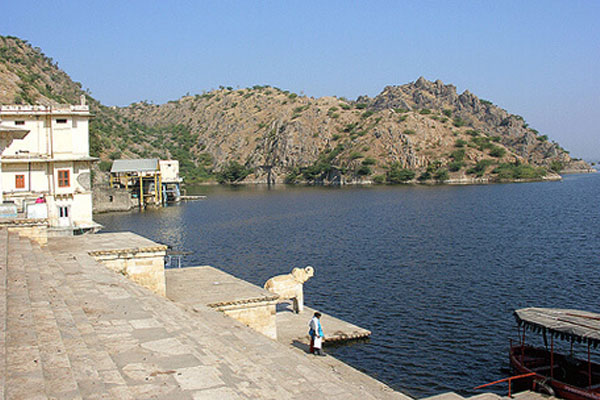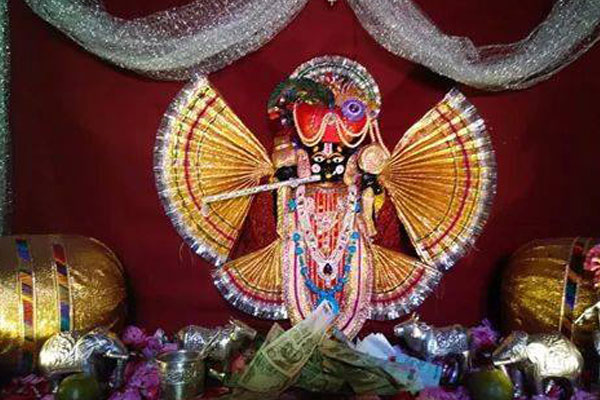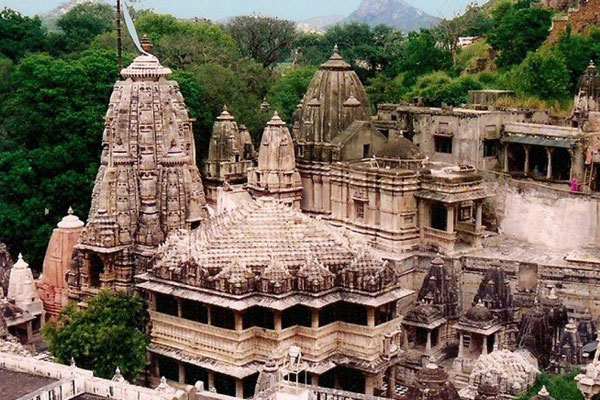
Near By Attractions

Sanwaria Ji Temple
Sanwaliya ji Seth is an avatar of Lord Krishna. Sanwaliya ji is also known as sanwariya ji and sanwariya seth or sanwara seth. Sanwariya ji setho ke seth (banker of the bankers). The history of this temple goes back to about 250 years back, when a cow-heard name Bholaram Gurjar in his dream saw that 4 statues of a diety is burried at a place called Bhadsoda. Upon digging that place, the dream came true. One statue was destroyed in the process, which was again re-buried. All the three statues look exactly the same. It is a very beautiful Krishna statue, with Lord Krishna playing flute. These statues are present even today at Bhadsoda and Mandpiya villages, near Chittorgarh of Rajasthan. This is a very powerful and magical place of Lord Krishna.
Jaisamand Lake
Jaisamand Lake was the largest artificial lake in Asia, till the time when Aswan Dam of Egypt was not constructed. The dam on this lake is worth mentioning due to its massive size. It is 1202 feet in length, 116 feet in height and width of 70 feet at the bottom. The kings of Mewar were religious by nature and this is conformed by the fact that this dam has a Shiva temple. Centrally located, this temple dedicated to Lord Shiva. Jaisamand Lake is close to the sanctuary that serves habitat to various types of birds, panthers, leopards, deer, wild boars and crocodiles. Once, these woods used to form the hunting ground of the erstwhile rulers of Mewar. In 1957, Jaisamand Sanctuary was built to cover an area of 62sqkm. This sanctuary hails a large variety of resident and migratory birds and animals. In the present date, it has been converted into a game sanctuary.


Kumbhalgarh Fort
Kumbhalgarh Fort is a Mewar fortress in the Rajsamand District of Rajasthan state in western India. It is a World Heritage Site included in Hill Forts of Rajasthan. Built during the course of the 15th century by Rana Kumbha and enlarged through the 19th century, Kumbhalgarh is also the birthplace of Maharana Pratap, the great king and warrior of Mewar. Occupied until the late 19th century, the fort is now open to the public and is spectacularly lit for a few minutes each evening. Kumbalgarh is situated 82 km northwest of Udaipur by road. It is the most important fort in Mewar after Chittaurgarh. It is on a hilltop 1100 metres above sea level, the fort of Kumbhalgarh has perimeter walls that extend 36 kilometres, and it is the second longest wall in the world.
The Jain temple Ranakpur
Ranakpur is a village located in Desuri tehsil near Sadri town in the Pali district of Rajasthan in western India. It is located between Jodhpur and Udaipur. 162 km from Jodhpur and 91 km from Udaipur, in a valley on the western side of the Aravali Range. Ranakpur is widely known for its marble Jain temple, said to be the most spectacular of the Jain temples. There is also a small Sun temple which is managed by the Udaipur royal family trust. The Ranakpur Jain Temple was built during the reign of the liberal and gifted Rajput monarch Rana Kumbha in the 15th century, in the AD 1439. The basement is of 48,000 sq. feet area that covers the whole complex. There are four subsidiary shrines, twenty-four pillared halls and domes supported by over four hundred columns. The total number of columns is 1,444 all of which are intricately carved with no two being alike.


Mt Abu
Mount Abu is a popular hill station in the Aravali Range in Sirohi district of Rajasthan state in western India near the border with Gujarat. The mountain forms a distinct rocky plateau 22 km long by 9 km wide. The highest peak on the mountain is Guru Shikhar at 1,722 m (5,650 ft) above sea level. It is referred to as 'an oasis in the desert' as its heights are home to rivers, lakes, waterfalls and evergreen forests. Nearest Railway station is Abu Road Railway station which is 27 km away. Mount Abu town, the only hill station in Rajasthan, is located at an elevation of 1,220 m (4,003 ft). It has been a popular retreat from the heat of Rajasthan and neighbouring Gujarat for centuries. The Mount Abu Wildlife Sanctuary was established in 1960 and covers 290 km² of the mountain. The mountain is also home to several Hindu temples, including the Adhar Devi Temple (also known as Arbuda Devi Temple), carved out of solid rock; the Shri Raghunathji Temple; and a shrine and temple to Dattatreya built atop the Guru Shikhar peak and a number of Jain temples including Dilwara Temples, a complex of temples carved of white marble that was built between the 11th and 13th centuries AD. The oldest of these is the Vimal Vasahi temple.
Nathdwara
Nathdwara is a town in Rajasthan state of western India. It is located in the Aravali hills, on the banks of the Banas River in Rajsamand District, 48 kilometres north-east of Udaipur. This town is famous for its temple of Krishna which houses the idol of Shrinathji, a 14th-century, 7-year-old "infant" incarnation of Krishna. Nathdwara town is also famous as the Apollo of Mewar. In the town of Nathdwara, Shrinathji temple is the centre of attraction, but the town is also famous for its 'pichhwai' paintings, handmade terracottas, ivory articles and milk-made sweets. During the times of Holi, Diwali and Janmashtmi, people throng in large numbers. Apart from festivals like Holi and Janmashtmi, Annakutta (Linked to Krishna lifting Govardhana Hill) is a major festival that is celebrated in the temple. Nathdwara is known for Pichwais (Large paintings on cloth depicting legends from the life of Lord Krishna ) and Haweli music (devotional music, akin to dhrupad singing with composition meant for various seasons, festivals and sections of the day.


Haldi Ghati
Haldi Ghati is a mountain pass in the Aravali Range of Rajasthan in western India. It connects Rajsamand and Pali districts, 40 kilometres from Udaipur. The name is believed to have come from the turmeric-coloured yellow soil (Turmeric is haldi in Hindi). The mountain pass is historically significant as the location of the historic Battle of Haldighati, which took place in 1576 between Rana Pratap Singh of Mewar and Raja Man Singh of Amber, general of the Mughal emperor Akbar. The memorial features a bronze statue of the Maharana astride his favourite horse, “Chetakâ€. Haldighati is also world famous for its charity rose product and the mud art of Molela.
Eklingji
Eklingji is a Hindu temple complex in Udaipur District.The beautifully sculpted temple complex includes 108 temples within its high walls.The walled complex is made of marble and granite and has an enormous double-storied, elaborately pillared hall or "mandap" under a vast pyramidal roof, with a four-faced image of Lord Shiva in black marble. Another temple in the complex is the Lakulish Temple; built in 971, it is the only temple of the Lakulish sect in the whole of India. About 1 km from Eklingji, Nagda town is famous for its Sas Bahu Temples and Adbudji temples. The Sas-Bahu Temple is widely known for its exquisite stone carvings, which are related to incidents in the great Indian epic the Ramayana.


Chittorgarh
Chittorgarh Fort is the largest fort in India and the grandest in the state of Rajasthan. It sprawls majestically over a hill 180 m (590.6 ft) in height spread over an area of 280 ha (691.9 acres) above the plains of the valley drained by the Berach River. The fort precinct with an evocative history is studded with a series of historical palaces, gates, temples and two prominent commemoration towers. These monumental ruins have inspired the imagination of tourists and writers for centuries.
